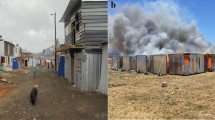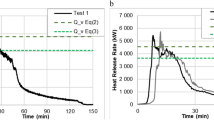Abstract
EcoSmartFire is a Windows program that models heat damage and piloted ignition of structures from radiant exposure to discrete landscaped tree fires. It calculates the radiant heat transfer from cylindrical shaped fires to the walls and roof of the structure while accounting for radiation shadowing, attenuation, and ground reflections. Tests of litter burn, a 0.6 m diameter fire up to 250 kW heat release under a Heat Release Rate (HRR) hood, with Schmidt-Boelter heat flux sensors in the mockup wall receiving up to 5 kW/m2 radiant flux, in conjunction with Fire Dynamic Simulator (FDS) modeling verified a 30% radiant fraction, but indicated the need for a new empirical model of flame extinction coefficient and radiation temperature as function of fire diameter and heat release rate for use in ecoSmartFire. The radiant fluxes predicted with both ecoSmartFire and FDS agreed with SB heat flux sensors to within a few percent errors during litter fire growth. Further experimental work done with propane flame heating (also with 30% radiant fraction) on vertical redwood boards instrumented with embedded thermocouples validated the predicted temperature response to within 20% error for both models. The final empirical correlation for flame extinction coefficient and temperature is valid for fire diameters between 0.2 and 7.9 m, with heat release rates up to 1000 kW. From the corrected radiant flux the program calculates surface temperatures for a given burn time (typically 30 s) and weather conditions (typically dry, windy, and warm for website application) for field applications of many trees and many structural surfaces. An example was provided for a simple house exposed to 4 burning trees selected on a Google enhanced mapping that showed ignition of a building redwood siding. These temperatures were compared to damage or ignition temperatures with output of the percentage of each cladding surface that is damaged or ignited, which a homeowner or a landscaper can use to optimize vegetation landscaping in conjunction with house exterior cladding selections. The need for such physics-based fire modeling of tree spacing was indicated in NFPA 1144 for home ignitability in wildland urban interface, whereas no other model is known to provide such capability.















Similar content being viewed by others
Abbreviations
- A :
-
Surface area (m2)
- Bi :
-
Biot number
- D :
-
Tree flame diameter (ft (m))
- c :
-
Heat capacity (J kg−1 K−1)
- δ m :
-
Cladding thickness (mm)
- ε m :
-
Tree flame emissivity (–)
- E b :
-
Blackbody total emissive flux (kWm−2)
- F i :
-
Cylindrical flame view factor in “I” direction (–)
- Fo :
-
Fourier number (−)
- Fr :
-
Froude number based on heat release rate (–)
- h :
-
Heat transfer coefficient (W m−2 K−1)
- H :
-
Tree flame height (ft (m))
- HRR :
-
Heat release rate of tree (kW)
- k :
-
Thermal conductivity (Wm−1 K−1)
- κ :
-
Smoke extinction coefficient (m−1)
- L :
-
Distance from surface element to flame center (m)
- m :
-
Tree wet mass (kg)
- MC :
-
Dry basis moisture content of tree foliage (%)
- q j :
-
Line of sight irradiance from tree fire j to surface element (kWm−2)
- ρ :
-
Cladding density (kg m−3)
- r :
-
Flame radius (m)
- R j :
-
Ground reflection coefficient around tree j (–)
- S j :
-
Mean beam length of tree fire j (m)
- σ:
-
Stefan-Boltzmann constant, (5.6696 × 10−8 × Wm−2 K−4)
- τ j :
-
Tree flame transmittance (–)
- θ 0 :
-
Upward rotation angle to flame top (radian)
- T :
-
Temperature (K)
- u :
-
Unit vector in x direction of element normal vector
- v :
-
Unit vector in y direction of element normal vector
- w :
-
Unit vector in z direction of element normal vector
- χ r :
-
Radiant fraction of heat release rate
References
NFPA 1144 (2013) Standard for reducing structure ignition hazards from wildland fires, copyright by National Fire Protection Association, 2012, 1 Batterymarch Park, Quincy, MA, 02169-7471
Cohen JD (2000) Preventing disaster: home ignitability in the wildland-urban interface. J For (March 2000):15–21
Cohen JD (2008) The wildland-urban interface fire problem: a consequence of the fire exclusion paradigm. For Hist Today Fall 20–26
Firewise Communities (2008) Firewise guide to landscape and construction, FWC-200-08-PH, copyright by National Fire Protection Association, 2012, 1 Batterymarch Park, Quincy, MA, 02169-7471
Nader G, Nakamura G, DeLasaux MD, Quarles S, Valachovic Y (2007) Home landscaping for fire, UC-ANR-Publication 8228, copyright by The Regents of the University of California, 2007, Division of Agriculture and Natural Resources
IWUIC (2011) 2012 International Wildland-Urban Interface Code, copyright by International Code Council, Inc., 4051 West Flossmoor Road, Country Club Hills, IL, 60478
Babrauskas VB (2003) Chapter 13. Special topics in ignition handbook, pp 629–631, copyright by Vytenis Babrauskas, Published by Fire Science Publishers, Issaquah, WA 98027. ISBN 0-9728111-3-3
Ellis P, Sullivan A (2004) The significance of suburban fuels, final CSIRO client report 1471 for Fire Management Unit Department of Urban Services ACT Government, CSIRO Contract No. FFP 04/144
Howard RA, North DW, Offensend FL, Charles N. Smart (1973) Decision analysis of fire protection strategy for the santa Monica mountains: an initial assessment. SRI Project MSU-2275, Stanford Research Institute, Menlo Park, CA
Foote EID (1994) Structure survival on the 1990 Santa Barbara” Paint” fire: a retrospective study of urban-wildland interface fire hazard mitigation factors. M.S. Thesis, University of California, Berkeley
Tran HC, Cohen JD, Chase RA (1992) Modeling ignition of structures in wildland/urban interface fires. In: Proceedings of 1st intl fire and materials conference; 1992 September 24–25; Arlington, VA; 1992: pp 253–262.
Manzello SL, Foote EID (2014) Characterizing firebrand exposure from wildland–urban interface (WUI) fires: results from the 2007 angora fire. Fire Technol 50:105–124
Mutch RW, Rogers MJ, Stephens SL, Gill AM (2011) Protecting lives and property in the wildland–urban interface: communities in Montana and southern California adopt Australian paradigm. Fire Technol 47(2):357–377
Caton SE, Gorham DJ, Zhou A (2016) Review of pathways for building fire spread in the wildland urban interface part i: exposure conditions. Fire Technol. doi:10.1007/s10694-016-0589-z
McPherson G, Xiao Q, Purohit J, Dietenberger M, Boardman CCR, Simpson J, Peper P (2014) ecoSmart landscapes: a versatile SaaS platform for green infrastructure applications in urban environments. International Environmental Modelling and Software Society (iEMSs), 7th International congress on environmental modelling and software, San Diego, CA, USA
Babrauskas V (2008) Section 3, chapter 1. Heat release rates in the SFPE handbook of fire protection engineering, 4th edn, pp 3–34, 35
Tien CL, Lee KY, Stretton AJ (2008) Section 1, radiation heat transfer. In: The SFPE handbook of fire protection engineering, 4th edn, pp 1–83, 84
Dayan A, Tien CL (1974) Radiant heating from a cylindrical fire column. Combust Sci Technol 9:41–47
Heskestad G (2008) Section 2, Chap. 1, fire plumes, flame height, and air entrainment. In: The SFPE Handbook of Fire Protection Engineering, 4th edn, pp 2–4
Quintiere JG, Grove BS (1998) A unified analysis for fire plumes, 27th symposium (international) on combustion. The Combustion Institute, pp 2757–2766
Tewarson A (2008) Section 3, chapter 4, generation of heat and chemical compounds in fires, Table 3-4.11. In: The SFPE handbook of fire protection engineering, 4th edn., pp 3–78.
Tewarson A (2004) Combustion efficiency and its radiative component. Fire Saf J 39:131–141
Chatterjee P, de Ris JL, Wang Y, Dorofeev SB (2011) A model for soot radiation in buoyant diffusion flames. In: Proceedings of the combustion institute 33:2665–2671
Wen JX, Kang K, Donchev T, Karwatzki JM (2007) Validation of FDS for the prediction of medium-scale pool fires. Fire Saf J 42:127–138.
25. Dupuy, J.L., Vachet,P., Marechal, J., Melendez, J., de Castro, A.J. (2007) Thermal infrared emission-transmission measurements in flames from a cylindrical forest fuel burner, Int. J. of Wildland Fire, 16 (2007) pp. 324-340.
26. Adiga, K.C., Ramaker, D.E., Tatem, P.A., and Williams, F.W. (1989), Modeling Pool-like Gas Flames of Propane, Fire Safety Journal, 14 (1989) pp. 241-250.
Dupuy JL, Marechal J, Morvan D (2003) Fires from a cylindrical forest fuel burner: combustion dynamics and flame properties. Combust Flame 135:65–76
Agueda A, Pastor E, Perez Y, Planas E (2010) Experimental study of the emissivity of flames resulting from the combustion of forest fuels. Int J Therm Sci 49:543–554
Dietenberger MA, Grexa O (2004) Ignitability of materials in transitional heating regimes. Wood & fire safety: proceedings, 5th international scientific conference, April 18–22, 2004. Slovak Republic. [Svolen, Slovakia]: Faculty of Wood Sciences and Technology, Technical University of Zvolen, 2004, pp 31–41
Dietenberger MA, Boardman CR (2013) HRR upgrade to mass loss calorimeter and modified Schlyter test for FR Wood. In: Proceedings of the fire and materials 2013 conference held at the Hyatt Hotel Fisherman’s Wharf Hotel, San Francisco, California, USA 28–30 January 2013, pp 251–263
Acknowledgements
Initial inspiration to undertake this rewrite of EcoSmart Fire was provided by Greg McPherson and Joe Purohit who worked on the larger ecoSmart landscapes web project with funding from CalFire. Part of the core EcoSmart Fire programming work was supported under their CalFire contract. Greg and Joe helped shape the initial scope of the project. Further validation work and continuing software refinement was supported by the Forest Products Laboratory. We thank FPL project leaders Carol Clausen and Sam Zelinka for their ongoing encouragement.
Author information
Authors and Affiliations
Corresponding author
Rights and permissions
About this article
Cite this article
Dietenberger, M.A., Boardman, C.R. EcoSmart Fire as Structure Ignition Model in Wildland Urban Interface: Predictions and Validations. Fire Technol 53, 577–607 (2017). https://doi.org/10.1007/s10694-016-0632-0
Received:
Accepted:
Published:
Issue Date:
DOI: https://doi.org/10.1007/s10694-016-0632-0




